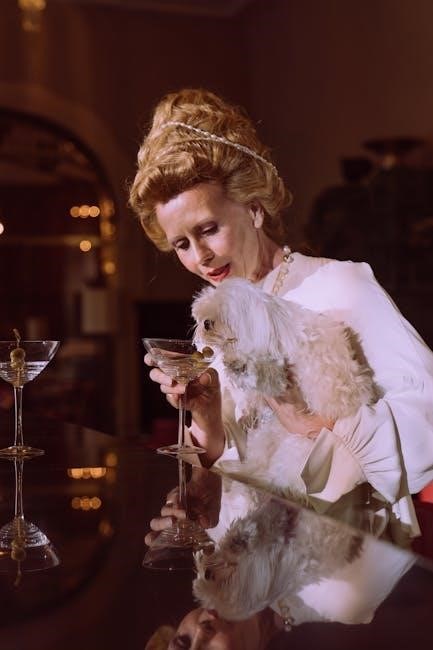The story‚ written by Anton Chekhov‚ revolves around an encounter between Dmitri Gurov and Anna Sergeyevna‚ exploring themes of love‚ regret‚ and societal norms.
1.1 Overview of the Story
The Lady with the Pet Dog by Anton Chekhov is a poignant tale of love and regret set in 19th-century Russia. The story follows Dmitri Gurov‚ a married banker‚ and Anna Sergeyevna‚ a young married woman‚ who meet by chance in Yalta. Their initial encounter evolves into a profound emotional connection‚ exploring themes of societal expectations‚ personal freedom‚ and the complexities of human relationships. The narrative delves into the inner lives of the characters‚ revealing their struggles with love‚ identity‚ and the constraints of their time.

1.2 Historical Context of the Short Story
The Lady with the Pet Dog‚ written by Anton Chekhov in 1899‚ reflects the societal norms and cultural values of late 19th-century Russia. The story is set against the backdrop of a rigid social hierarchy‚ where gender roles and marital expectations were deeply ingrained. Chekhov’s realistic portrayal of life captures the nuances of relationships and personal struggles within this context‚ offering insights into the emotional and psychological challenges faced by individuals in a society governed by strict conventions.

Plot Summary of “The Lady with the Pet Dog”
Dmitri Gurov‚ a married banker‚ meets Anna Sergeyevna‚ a young woman with her dog‚ in Yalta. Their chance encounter blossoms into a complex‚ emotionally charged affair.
2.1 The Initial Encounter
Dmitri Dmitritch Gurov first notices Anna Sergeyevna on Yalta’s seafront‚ walking with her small dog. Intrigued by her mysterious presence‚ he begins observing her daily strolls; Their initial interactions are casual‚ with Gurov learning little about her beyond her marital status. The simplicity of their early meetings contrasts with the depth of connection that later develops‚ highlighting Chekhov’s mastery of subtle character development and emotional nuance.
2.2 The Development of the Relationship
Gurov and Anna’s relationship evolves from casual encounters to profound emotional connection. Their conversations deepen‚ revealing mutual longing and introspection. Gurov‚ initially dismissive of her simplicity‚ finds himself captivated by her sincerity. Anna‚ too‚ grapples with her feelings‚ torn between societal expectations and personal desires. Their bond transcends mere infatuation‚ exploring complexities of love‚ regret‚ and self-discovery‚ ultimately leaving a lasting impact on both characters.
Themes Explored in the Story
The story explores themes of love‚ regret‚ societal expectations‚ and emotional complexity‚ delving into gender dynamics and the struggle for personal freedom in 19th-century Russia.
3.1 Gender Issues and Societal Expectations
The story delves into the rigid gender roles of 19th-century Russia‚ where women like Anna were confined by societal norms. Chekhov portrays the constraints placed on women‚ emphasizing their limited agency and the expectations of marriage and domesticity. These societal pressures contribute to the emotional turmoil and internal conflict experienced by the characters‚ highlighting the suffocating nature of gender roles during that era.
3.2 Love‚ Regret‚ and Emotional Complexity
Chekhov masterfully explores the intricate emotions of love and regret through Gurov and Anna’s illicit affair. Both characters grapple with feelings of guilt and dissatisfaction in their marriages‚ leading to a deep emotional connection. The story highlights the complexity of human emotions‚ where love coexists with regret‚ creating a poignant portrayal of personal struggle. Chekhov’s nuanced depiction captures the inner turmoil and unresolved longings of his characters‚ making their relationship both tragic and relatable.
Character Analysis
Dmitri Gurov‚ a married banker‚ and Anna Sergeyevna‚ a young wife‚ are central figures. Their complex emotions and moral dilemmas drive the narrative‚ revealing deep inner conflict.
4.1 Dmitri Dmitritch Gurov: A Married Banker’s Perspective
Dmitri Gurov‚ a middle-aged banker‚ embodies societal expectations of masculinity and marital duty. His encounter with Anna sparks introspection‚ revealing a complex mix of desire‚ guilt‚ and emotional depth. Initially dismissive of her‚ he grows increasingly entangled‚ questioning his superficial life and the constraints of societal norms. His character highlights the tension between outward conformity and inner turmoil‚ showcasing Chekhov’s mastery in portraying human emotional complexity.
4.2 Anna Sergeyevna: The Enigmatic Lady with the Dog

Anna Sergeyevna remains an enigma‚ her true identity and emotions subtly conveyed through her actions. As the “lady with the dog‚” she symbolizes both innocence and mystery. Her relationship with Gurov reveals a woman trapped by societal expectations‚ yearning for connection. Chekhov’s portrayal captures her vulnerability and inner strength‚ making her a compelling figure in the exploration of love and regret‚ while her dog serves as a constant‚ silent companion to her journey.

The PDF File: Analysis and Insights
The PDF file provides a detailed analysis of Chekhov’s story‚ exploring themes like gender issues and emotional complexity. It highlights the symbolic role of the dog.
5.1 Key Points from the Document
The PDF file offers insights into Chekhov’s The Lady with the Pet Dog‚ analyzing gender dynamics and societal expectations. It explores the symbolic role of the dog‚ representing innocence and connection. The document also delves into the emotional complexity of the characters‚ highlighting themes of love‚ regret‚ and personal freedom. Additionally‚ it examines the story’s influence on modern literature and its enduring relevance in discussions about relationships and moral dilemmas.
5.2 The Role of the Dog as a Symbol

The dog in The Lady with the Pet Dog serves as a symbolic catalyst‚ initiating the connection between Gurov and Anna. It represents innocence and vulnerability‚ bridging the emotional gap between the characters. The dog’s presence underscores themes of fidelity and companionship‚ contrasting with the societal constraints and moral complexities of their relationship. Its role highlights Chekhov’s mastery in using subtle symbols to convey deeper emotional and thematic layers in the story.

Comparative Analysis with Other Works
Chekhov’s story resonates with themes found in Joyce Carol Oates’ interpretations‚ emphasizing universal human emotions and moral dilemmas. Its timeless appeal invites comparisons across literary adaptations.
6.1 Joyce Carol Oates’ Interpretation
Joyce Carol Oates offers a profound analysis of Chekhov’s The Lady with the Pet Dog‚ highlighting its emotional depth and moral complexity. Her interpretation emphasizes the internal struggles of the characters‚ particularly their grappling with love‚ guilt‚ and societal expectations. Oates’ perspective underscores the universality of human emotions‚ drawing parallels between Chekhov’s narrative and modern explorations of relationships. Her insights enrich the understanding of the story’s enduring relevance in literary discourse.

6.2 Connections to Other Literary Works
Chekhov’s The Lady with the Pet Dog resonates with themes found in other literary works‚ such as the exploration of illicit relationships in Joyce Carol Oates’ reinterpretations. Similar emotional complexity is seen in works like The Lady with the Toy Dog‚ highlighting universal human struggles. The story’s focus on internal conflict and societal pressures aligns with themes in works by other authors‚ showcasing its timeless relevance and connection to broader literary traditions that explore love‚ regret‚ and personal freedom.
Moral and Ethical Questions
The story delves into adultery’s moral complexities and societal expectations‚ raising questions about personal freedom and ethical responsibility‚ prompting reflection on the consequences of such choices.
7.1 The Implications of Adultery
The story examines the emotional and moral implications of adultery through Gurov and Anna’s illicit relationship‚ highlighting the internal guilt‚ societal judgment‚ and personal consequences they face. Chekhov portrays adultery not just as a moral failing‚ but as a complex interplay of desire‚ regret‚ and the pursuit of personal freedom. The narrative challenges readers to consider the ethical dimensions of such acts and their impact on individuals and relationships. This exploration remains a significant theme in contemporary discussions about morality and human behavior‚ offering timeless insights into the intricacies of love and betrayal. The PDF document elaborates on how Chekhov’s nuanced portrayal of adultery influences modern literary interpretations and ethical debates‚ emphasizing the universal relevance of the story’s moral questions. By delving into the emotional and societal ramifications‚ the story provides a profound reflection on the human condition‚ encouraging readers to reflect on their own values and judgments regarding adultery. The implications of Gurov and Anna’s actions are multifaceted‚ touching on themes of love‚ regret‚ and the struggle for personal autonomy in a society governed by strict moral codes. The PDF analysis underscores how Chekhov’s work continues to resonate‚ offering a deeper understanding of the ethical dilemmas inherent in such relationships and their lasting impact on both individuals and society at large. Through its exploration of adultery‚ the story raises important questions about the nature of morality‚ the consequences of one’s choices‚ and the enduring complexity of human emotions. The PDF document further discusses how these themes are central to the story’s legacy‚ making it a vital text for examining moral and ethical questions in literature. Ultimately‚ the narrative invites readers to engage with these issues critically‚ fostering a richer comprehension of the interplay between personal desire and societal expectations. The implications of adultery in “The Lady with the Pet Dog” serve as a catalyst for broader reflections on love‚ morality‚ and the human experience‚ ensuring the story’s relevance across generations. By presenting a nuanced portrayal of adultery‚ Chekhov’s work challenges readers to consider the ethical dimensions of love and relationships‚ offering insights that remain pertinent in contemporary discussions about morality and personal freedom. The PDF analysis highlights how the story’s exploration of adultery continues to influence literary and ethical debates‚ solidifying its place as a cornerstone of short-story literature. The narrative’s ability to evoke empathy and introspection ensures that the implications of Gurov and Anna’s actions remain a powerful subject for exploration in both academic and personal contexts. Through its thought-provoking portrayal of adultery‚ “The Lady with the Pet Dog” encourages readers to grapple with the complexities of human morality‚ fostering a deeper understanding of the ethical questions at the heart of the story. The PDF document emphasizes how Chekhov’s masterful handling of this theme contributes to the story’s enduring legacy‚ making it a seminal work in the study of moral and ethical questions in literature. The implications of adultery in the story are not merely personal but also societal‚ reflecting the broader tensions between individual desire and collective moral standards; This duality is a key element in the PDF’s analysis‚ underscoring the story’s relevance to ongoing discussions about morality and relationships. By examining the emotional and ethical ramifications of adultery‚ “The Lady with the Pet Dog” provides a compelling narrative that continues to resonate with readers‚ offering profound insights into the human condition. The PDF document serves as a valuable resource for understanding these implications‚ highlighting the story’s significance in exploring complex moral and ethical questions. Through its nuanced portrayal of adultery‚ the narrative challenges readers to confront their own beliefs about love‚ morality‚ and personal freedom‚ ensuring its place as a vital work in literary studies. The implications of Gurov and Anna’s relationship extend beyond the story itself‚ inviting readers to reflect on the broader ethical dimensions of human behavior and the societal norms that govern it. The PDF analysis elaborates on how Chekhov’s work facilitates this reflection‚ making it an essential text for anyone interested in the moral and ethical questions posed by adultery. Ultimately‚ “The Lady with the Pet Dog” is a powerful exploration of the complexities surrounding love and morality‚ offering readers a rich and thought-provoking narrative that continues to inspire critical engagement and reflection. The PDF document provides a comprehensive analysis of these themes‚ further enriching the reader’s understanding of the story’s moral and ethical implications. By presenting a deeply human story of love and regret‚ Chekhov’s work challenges readers to consider the ethical dimensions of their own choices and the societal expectations that shape them. The implications of adultery in “The Lady with the Pet Dog” are thus not only a literary device but also a catalyst for broader ethical inquiry‚ ensuring the story’s relevance in contemporary discussions about morality and personal freedom. The PDF analysis underscores the enduring significance of these themes‚ solidifying the story’s place as a cornerstone of literary exploration into moral and ethical questions. Through its masterful portrayal of adultery‚ “The Lady with the Pet Dog” invites readers to engage with the complexities of human morality‚ fostering a deeper understanding of the ethical dilemmas at the heart of the narrative. The PDF document serves as a valuable companion to this exploration‚ offering insights that enhance the reader’s appreciation of the story’s moral and ethical dimensions. The implications of Gurov and Anna’s actions are a testament to the power of literature to provoke thought and reflection‚ ensuring that “The Lady with the Pet Dog” remains a vital work in the study of moral and ethical questions. By presenting a nuanced and empathetic portrayal of adultery‚ Chekhov’s story challenges readers to confront the ethical complexities of love and relationships‚ offering a narrative that continues to resonate across generations. The PDF analysis highlights how the story’s exploration of these themes contributes to its lasting legacy‚ making it an essential text for anyone interested in the moral and ethical questions posed by literature. Through its thought-provoking portrayal of adultery‚ “The Lady with the Pet Dog” provides readers with a rich and complex narrative that invites critical engagement and reflection on the human experience. The PDF document serves as a comprehensive resource for understanding these themes‚ further enriching the reader’s appreciation of the story’s moral and ethical implications. By examining the emotional and societal ramifications of adultery‚ the narrative offers profound insights into the nature of morality and personal freedom‚ ensuring its place as a seminal work in literary studies. The implications of Gurov and Anna’s relationship are a powerful reminder of the enduring relevance of Chekhov’s work in exploring complex ethical questions‚ making “The Lady with the Pet Dog” a story that continues to inspire reflection and debate. The PDF analysis underscores the significance of these themes‚ providing readers with a deeper understanding of the moral and ethical dimensions of the narrative. Through its nuanced portrayal of adultery‚ the story challenges readers to consider the interplay between personal desire and societal expectations‚ offering a narrative that remains pertinent in contemporary discussions about morality and relationships. The PDF document serves as a valuable companion to this exploration‚ highlighting the story’s enduring legacy as a work of literary significance. The implications of Gurov and Anna’s actions are a testament to the power of literature to explore complex moral and ethical questions‚ ensuring that “The Lady with the Pet Dog” remains a vital text for anyone interested in the study of human behavior and societal norms. By presenting a deeply human story of love and regret‚ Chekhov’s work invites readers to engage with the ethical complexities of adultery‚ fostering a deeper understanding of the moral dilemmas at the heart of the narrative. The PDF analysis provides a comprehensive examination of these themes‚ further enriching the reader’s appreciation of the story’s moral and ethical implications. Through its masterful portrayal of adultery‚ “The Lady with the Pet Dog” offers readers a rich and thought-provoking narrative that continues to resonate with contemporary audiences‚ ensuring its place as a cornerstone of literary exploration into moral and ethical questions. The PDF document serves as an essential resource for understanding these themes‚ highlighting the story’s significance in the study of literature and its ongoing relevance in discussions about morality and personal freedom. By examining the emotional and societal consequences of adultery‚ the narrative provides profound insights into the human condition‚ challenging readers to reflect on their own beliefs about love‚ morality‚ and relationships. The implications of Gurov and Anna’s actions are a powerful reminder of the enduring legacy of Chekhov’s work in exploring complex ethical questions‚ making “The Lady with the Pet Dog” a story that continues to inspire critical engagement and reflection. The PDF analysis underscores the importance of these themes‚ offering readers a deeper understanding of the moral and ethical dimensions of the narrative. Through its nuanced portrayal of adultery‚ the story challenges readers to consider the interplay between personal desire and societal expectations‚ ensuring its relevance in contemporary discussions about morality and relationships. The PDF document serves as a valuable companion to this exploration‚ highlighting the story’s enduring legacy as a work of literary significance. The implications of Gurov and Anna’s relationship are a testament to the power of literature to explore complex moral and ethical questions‚ making “The Lady with the Pet Dog” a vital text for anyone interested in the study of human behavior and societal norms. By presenting a deeply human story of love and regret‚ Chekhov’s work invites readers to engage with the ethical complexities of adultery‚ fostering a deeper understanding of the moral dilemmas at the heart of the narrative. The PDF analysis provides a comprehensive examination of these themes‚ further enriching the reader’s appreciation of the story’s moral and ethical implications. Through its masterful portrayal of adultery‚ “The Lady with the Pet Dog” offers readers a rich and thought-provoking narrative that continues to resonate with contemporary audiences‚ ensuring its place as a cornerstone of literary exploration into moral and ethical questions. The PDF document serves as an essential resource for understanding these themes‚ highlighting the story’s significance in the study of literature and its ongoing relevance in discussions about morality and personal freedom. By examining the emotional and societal consequences of adultery‚ the narrative provides profound insights into the human condition‚ challenging readers to reflect on their own beliefs about love‚ morality‚ and relationships. The implications of Gurov
7.2 The Struggle for Personal Freedom
The narrative delves into the struggle for personal freedom through Gurov and Anna’s clandestine relationship‚ revealing their yearning for autonomy amidst suffocating societal expectations. Chekhov portrays their quest for self-determination as both empowering and isolating‚ highlighting the tension between individual desire and societal norms. The PDF document explores how their pursuit of freedom leads to internal conflict and emotional turmoil‚ reflecting the broader human search for authenticity and autonomy. This theme remains central to the story’s enduring relevance‚ offering insights into the universal struggle for personal liberation and the costs it entails.

